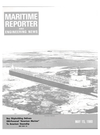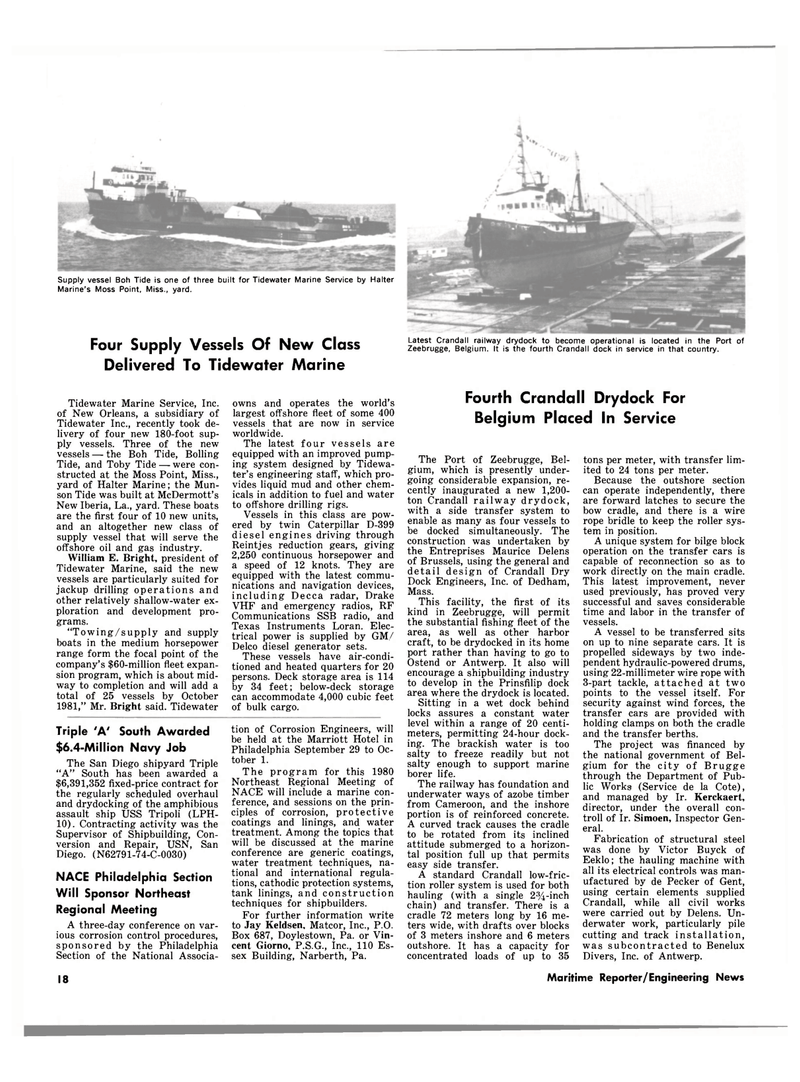
Page 16: of Maritime Reporter Magazine (May 15, 1980)
Read this page in Pdf, Flash or Html5 edition of May 15, 1980 Maritime Reporter Magazine
Supply vessel Boh Tide is one of three built for Tidewater Marine Service by Halter
Marine's Moss Point, Miss., yard.
Four Supply Vessels Of New Class
Delivered To Tidewater Marine
Latest Crandall railway drydock to become operational is located in the Port of
Zeebrugge, Belgium. It is the fourth Crandall dock in service in that country.
Fourth Crandall Drydock For
Belgium Placed In Service
Tidewater Marine Service, Inc. of New Orleans, a subsidiary of
Tidewater Inc., recently took de- livery of four new 180-foot sup- ply vessels. Three of the new vessels — the Boh Tide, Boiling
Tide, and Toby Tide — were con- structed at the Moss Point, Miss., yard of Halter Marine; the Mun- son Tide was built at McDermott's
New Iberia, La., yard. These boats are the first four of 10 new units, and an altogether new class of supply vessel that will serve the offshore oil and gas industry.
William E. Bright, president of
Tidewater Marine, said the new vessels are particularly suited for jackup drilling operations and other relatively shallow-water ex- ploration and development pro- grams. "Towing/supply and supply boats in the medium horsepower range form the focal point of the company's $60-million fleet expan- sion program, which is about mid- way to completion and will add a total of 25 vessels by October 1981," Mr. Bright said. Tidewater
Triple 'A' South Awarded $6.4-Million Navy Job
The San Diego shipyard Triple "A" South has been awarded a $6,391,352 fixed-price contract for the regularly scheduled overhaul and drydocking of the amphibious assault ship USS Tripoli (LPH- 10). Contracting activity was the
Supervisor of Shipbuilding, Con- version and Repair, USN, San
Diego. (N62791-74-C-0030)
INACE Philadelphia Section
Will Sponsor Northeast
Regional Meeting
A three-day conference on var- ious corrosion control procedures, sponsored by the Philadelphia
Section of the National Associa- owns and operates the world's largest offshore fleet of some 400 vessels that are now in service worldwide.
The latest four vessels are equipped with an improved pump- ing system designed by Tidewa- ter's engineering staff, which pro- vides liquid mud and other chem- icals in addition to fuel and water to offshore drilling rigs.
Vessels in this class are pow- ered by twin Caterpillar D-399 diesel engines driving through
Reintjes reduction gears, giving 2,250 continuous horsepower and a speed of 12 knots. They are equipped with the latest commu- nications and navigation devices, including Decca radar, Drake
VHF and emergency radios, RF
Communications SSB radio, and
Texas Instruments Loran. Elec- trical power is supplied by GM/
Delco diesel generator sets.
These vessels have air-condi- tioned and heated quarters for 20 persons. Deck storage area is 114 by 34 feet; below-deck storage can accommodate 4,000 cubic feet of bulk cargo. tion of Corrosion Engineers, will be held at the Marriott Hotel in
Philadelphia September 29 to Oc- tober 1.
The program for this 1980
Northeast Regional Meeting of
NACE will include a marine con- ference, and sessions on the prin- ciples of corrosion, protective coatings and linings, and water treatment. Among the topics that will be discussed at the marine conference are generic coatings, water treatment techniques, na- tional and international regula- tions, cathodic protection systems, tank linings, and construction techniques for shipbuilders.
For further information write to Jay Keldsen, Matcor, Inc., P.O.
Box 687, Doylestown, Pa. or Vin- cent Giorno, P.S.G., Inc., 110 Es- sex Building, Narberth, Pa.
The Port of Zeebrugge, Bel- gium, which is presently under- going considerable expansion, re- cently inaugurated a new 1,200- ton Crandall railway drydock, with a side transfer system to enable as many as four vessels to be docked simultaneously. The construction was undertaken by the Entreprises Maurice Delens of Brussels, using the general and detail design of Crandall Dry
Dock Engineers, Inc. of Dedham,
Mass.
This facility, the first of its kind in Zeebrugge, will permit the substantial fishing fleet of the area, as well as other harbor craft, to be drydocked in its home port rather than having to go to
Ostend or Antwerp. It also will encourage a shipbuilding industry to develop in the Prinsfilip dock area where the drydock is located.
Sitting in a wet dock behind locks assures a constant water level within a range of 20 centi- meters, permitting 24-hour dock- ing. The brackish water is too salty to freeze readily but not salty enough to support marine borer life.
The railway has foundation and underwater ways of azobe timber from Cameroon, and the inshore portion is of reinforced concrete.
A curved track causes the cradle to be rotated from its inclined attitude submerged to a horizon- tal position full up that permits easy side transfer.
A standard Crandall low-fric- tion roller system is used for both hauling (with a single 2%-inch chain) and transfer. There is a cradle 72 meters long by 16 me- ters wide, with drafts over blocks of 3 meters inshore and 6 meters outshore. It has a capacity for concentrated loads of up to 35 tons per meter, with transfer lim- ited to 24 tons per meter.
Because the outshore section can operate independently, there are forward latches to secure the bow cradle, and there is a wire rope bridle to keep the roller sys- tem in position.
A unique system for bilge block operation on the transfer cars is capable of reconnection so as to work directly on the main cradle.
This latest improvement, never used previously, has proved very successful and saves considerable time and labor in the transfer of vessels.
A vessel to be transferred sits on up to nine separate cars. It is propelled sideways by two inde- pendent hydraulic-powered drums, using 22-millimeter wire rope with 3-part tackle, attached at two points to the vessel itself. For security against wind forces, the transfer cars are provided with holding clamps on both the cradle and the transfer berths.
The project was financed by the national government of Bel- gium for the city of Brugge through the Department of Pub- lic Works (Service de la Cote), and managed by Ir. Kerckaert, director, under the overall con- troll of Ir. Simoen, Inspector Gen- eral.
Fabrication of structural steel was done by Victor Buyck of
Eeklo; the hauling machine with all its electrical controls was man- ufactured by de Pecker of Gent, using certain elements supplied
Crandall, while all civil works were carried out by Delens. Un- derwater work, particularly pile cutting and track installation, was subcontracted to Benelux
Divers, Inc. of Antwerp. 18 ZIDELL Maritime Reporter/Engineering News

 15
15

 17
17
